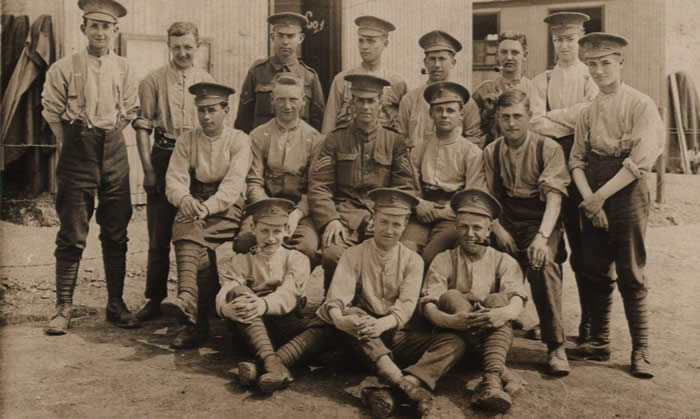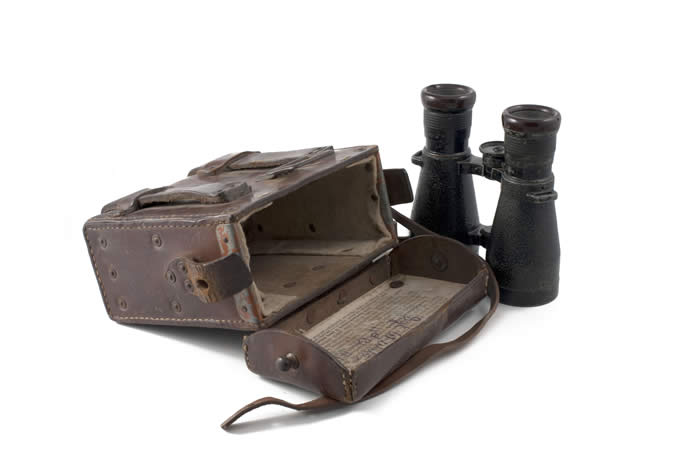Nature and Scope - Personal Experiences
"This digital project will give users an unparalleled opportunity to see the Great War through the eyes of the generation of 1914. These are the kinds of documents that put us in touch with the past in a very direct and immediate way – not official publications or newspaper accounts, but diaries, autograph books, candid snapshots, souvenirs, sketches and jottings, and other artefacts that are all too often lost to history. Drawn from archival collections around the world, The First World War: Personal Experiences offers remarkable glimpses at how people lived their lives during the Great War. It’s as close to history from the bottom up as we can get."
Professor Jonathan Vance
The University of Western Ontario
Introduction
The First World War: Personal Experiences is a wonderful collection of primary source documents drawn from archives across the globe. The documents are varied in scope and offer a remarkable window on the lives and experiences of men and women during the First World War. The resource is designed for both teaching and study, from undergraduate to research students and beyond.
Primary sources provide a rich seam of
information on subjects such as:
- Daily life and routines in the army and auxiliary services
- Trench warfare and conditions in the trenches
- Food and supplies
- Battles and warfare
- Training and discipline
- Weapons and equipment
- Camaraderie and friendship
- Death
- Health and medicine
- Thoughts on the enemy
More complex themes of faith, morale, citizenship, mortality, masculinity, race and class can also be explored.
A wide variety of material types are provided, including:
- Diaries and journals
- Letters
- Personal narratives and reminiscences
- Trench literature and soldiers’ journals
- Postcards
- Scrapbooks and albums
- Photographs and 360° views of personal items and objects
- Oral histories
- Sketches and paintings
- Ephemera
- Sheet music
- Photographs
- War art
- Cartoons and comics
- Propaganda and recruiting posters
- Trench maps
The resource includes a significant collection of digitally captured objects used during the war period which have been sourced from museums and collections in the Ypres region. Many smaller and medium size objects are presented in 360° mode such as helmets, gas masks, hats, shells and grenades. Our innovative 360° object viewer enables browsers to manipulate the movement of an object within the frame allowing them to view the object from every angle. Also included are 50 oral histories of veterans and those who lived through the First World War, sourced from the Sound Archive at Imperial War Museums, and featuring accompanying transcriptions.
Supplementing the primary source material is a wealth of secondary resources, including interactive maps, 360° panoramas and walk-throughs of the Sanctuary Wood Trench System, the Memory Wall, In Their Own Words feature, scholarly essays, a visual gallery, chronology and glossary.
Libraries and archives represented include:
Alexander Turnbull Library, National Library of New Zealand
Dr Kate Hunter (Victoria University of Wellington) has selected material for the resource from the Library’s First World War collections. Among the papers are letters of Maori soldiers, the diary of a woman serving as an ambulance driver in France in 1917, the diaries and letters of three brothers all serving in the war, and the diaries of a woman doctor that record her work with allied troops in Serbia and in England.
Cambridge University Library
This collection includes trench journals, personal narratives and visual sources from the Library’s renowned War Reserve Collection, with additional material from the general manuscript collections. Professor Jay Winter has described trench journals as an “indispensable source for any study of the military and social history of the Great War” and Cambridge is one of only a few libraries rich in this material.
Bibliothek für Zeitgeschichte in the Württembergische Landesbibliothek, Stuttgart
This collection includes material from the Library’s extensive collection of German trench newspapers. Titles include Feldzeitung der 5. Armee: Neueste Nachrichten, Kriegs-Zeitung der 4. Armee, Armee-Zeitung Jildirim, Deutsche Kriegszeitung von Baranowitschi and Der Stosstrupp: Feldzeitung der Armee-Abteilung A.
Brotherton Library, University of Leeds
We have included a wide-ranging selection of diary and letter collections from the prominent Liddle Collection in the resource. These include the papers of British, French, Australian and New Zealand troops serving on the Western Front and in Africa, Mesopotamia, Egypt, Palestine and Gallipoli.
Mills Memorial Library, McMaster University, Canada
The Library’s First World War collections are wide-ranging in scope and rich in visual content. We have digitised a major part of their collection which includes hundreds of personal collections, albums, photographs, trench journals, sheet music, visual sources and trench maps. We are also delighted to be including material from the Vera Brittain Archive in the project. This material includes her remarkable wartime diaries and letters and a heavily annotated first version of her celebrated autobiography Testament of Youth.
National World War I Museum at Liberty Memorial, Kansas City
We have digitised the Museum’s camp newspaper and sheet music collections. We have also included a wealth of visual sources from the Museum’s archive including their extensive postcard and poster collections.
Over the Top Collection
This personal collection features twenty-five 360° perspective views of helmets, caps, gas masks, binoculars, fuse cones, grenades and trench art. Another 400 colour images feature cap badges, shoulder strap titles and other unit insignia for British, Canadian, Australian and New Zealand units, along with weaponry and personal effects. Objects such as bed plates, belts, compasses or range finding equipment, flare pistols, tins of polish and trenching spades help bring alive the experiences of the Western Front.
Hooge Crater Museum
This Museum is located just outside Ypres on the Menin Road. Our new object viewer enables users to see over 90 objects in 360° perspective. Colour stills are provided for a further 250 objects, including kit, personal items and weapons. The digitised items include soldiers’ everyday items such as helmets, canteens, shaving kits, playing cards, cigarette packets, emergency money, unit insignia, gas masks, trenching tools and weapons.
* Please note: If you have purchased Module 1 only, you will not have access to Module 2 and Module 3 documents and primary source links within the secondary contextual material.



